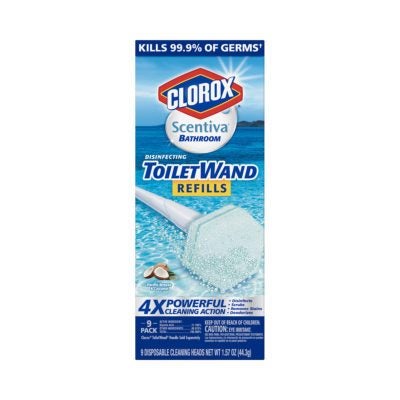– OR –
Ingredients Inside :Clorox® Scentiva® Bathroom Disinfecting Toilet Wand [Pacific Breeze & Coconut] (Refill) 44600319322
-
Product Name and UPC: Clorox® Scentiva® Bathroom Disinfecting Toilet Wand [Pacific Breeze & Coconut] (Refill) 44600319322
-
Brand: Clorox
-
Country: United States

Product Name and UPC: Clorox® Scentiva® Bathroom Disinfecting Toilet Wand [Pacific Breeze & Coconut] (Refill) 44600319322
Product Ingredients
- Substrate
- A substrate is the fabric used for cleaning wipes and pads.
- Water
- Water, also sometimes listed on product labels as aqua, is the most widely used of all solvents. It is a colorless, odorless and flavorless liquid and serves as the base of many cleaning products.
- C9-11 Alkyl Polyglucoside
- C9-11 alkyl polyglucoside is a mild surfactant used in household and commercial cleaning products. It is known for its foam boosting ability, lack of streaking and easy rinsing.
- Glycolic Acid
- Glycolic acid is an organic acid used as a cleaner or an antibacterial agent in EPA-registered cleaning products. It can remove discoloration, soap scum and mineral scale deposits left by hard water on fixtures such as toilets, bathtubs and sinks.
- Sodium Lauryl Sulfate
- Sodium lauryl sulfate, also called SLS, is a surfactant commonly used in household cleaners, detergents and soaps because of its soil removing and foaming abilities.
- Disodium Lauryl Phenyl Ether Disulfonate
- Disodium lauryl phenyl ether disulfonate is used as a mixture that acts as a surfactant often used in bleach products since it remains stable in such formulas.
- Fragrance
- Fragrances and perfumes are mixtures of fragrant essential oils, aroma compounds, fixatives and solvents. They are used in cleaning products to add a particular scent (lavender, lemon, etc.) to clothes and homes, and to mask unpleasant odors. Clorox provides a separate list of all the fragrance ingredients used in our household and professional cleaning, disinfecting and laundry products.
- Alpha-Isomethyl Ionone
- Alpha-isomethyl ionone is a synthetic fragrance ingredient that is commonly used in personal care products. It has been identified as a potential allergen by the Scientific Committee on Consumer Safety, an advisory board to the European Union.
- Butylphenyl Methylpropional
- Butylphenyl methylpropional is a synthetic fragrance ingredient that appears as a colorless to pale yellow liquid with a powerful, floral-fresh odor. It is commonly used in cosmetics, personal care products, and cleaning products. It has been identified as a potential allergen by the Scientific Committee on Consumer Safety, an advisory board to the European Union.
- Citronellol
- Citronellol is a fragrance ingredient with a rose scent, and is naturally occurring in plants, such as geraniums and roses. It is a commonly used ingredient in cosmetics, personal care products, and cleaning products. It has been identified as a potential allergen by the Scientific Committee on Consumer Safety, an advisory board to the European Union.
- Coumarin
- Coumarin is a commonly used fragrance ingredient that is a natural component of a wide variety of plants, such as lavender and woodruff. It has been identified as a potential allergen by the Scientific Committee on Consumer Safety, an advisory board to the European Union.
- Geraniol
- Geraniol is a fragrance compound that is found naturally in geranium, citranella or rose oil. It has been identified as a potential allergen by the Scientific Committee on Consumer Safety, an advisory board to the European Union.
- Linalool
- Linalool is a fragrance ingredient that carries a floral odor, and is naturally produced from a wide variety of plants, such as cinnamon and citrus plants, and can also be produced synthetically. It is a commonly used ingredient in cosmetics, personal care products, and cleaning products. It has been identified as a potential allergen by the Scientific Committee on Consumer Safety, an advisory board to the European Union.
- Liquitint® Aquamarine Dye
- Liquitint® Aquamarine Dye is a colorant (dye or pigment) added to cleaning products to improve aesthetic appeal, or to act as a tracer (for example in certain toilet bowl cleaners, blue coloration indicates that the product is working). They can be made from both synthetic and natural materials.
Clorox lists all fragrance components identified as potential allergens by the Scientific Committee on Consumer Safety, an advisory board to the European Union, when they are present at a concentration of more than 0.01 percent or greater in the product and provides a separate list of all the fragrance ingredients used in our household and professional cleaning, disinfecting and laundry products.
Product ingredients are listed based on the most current information available; please check back periodically for formulation updates. If you have questions regarding a product or the ingredient listing for a product, please contact us for additional information.
